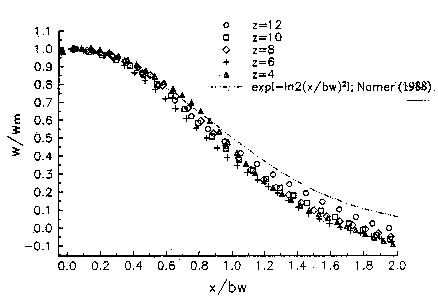Uniform eddy Viscosity Model
Assume that  is also independent of η so that is also independent of η so that
is a constant. The resulting mathematical problem for the profile  is is
 |
(21.3) |
where  is a constant and the boundary conditions are is a constant and the boundary conditions are
The final solution is
 |
(21.4) |
The choice l=bw requires  which implies that which implies that
 |
(21.5) |
This profile agrees well with measured profiles except at the edges of the jet where the entrainment and intermittency are important.
The measured value of the rate of spread is
implies now that,
using 
Measurement of the mean and fluctuating properties of a plane jet [1] support the results of the similarity argument and are in good qualitative agreement with measurements of Wygnanski et al. [2] in an axisymmetric jet. The LES computation [3] also reveals the self-similar profile of turbulent jet (see Figure 21.1). Here the numerical results have been compared with the experiments of Namer and Otugen [4]. The parameter z indicates non-dimensional distance from the orifice.
The quantity w is the axial velocity, Wm is its value at the centreline, x is the normal distance from the axis and bw is the half-width.

Figure 21.1: Self-similar velocity profile of a turbulent jet
|